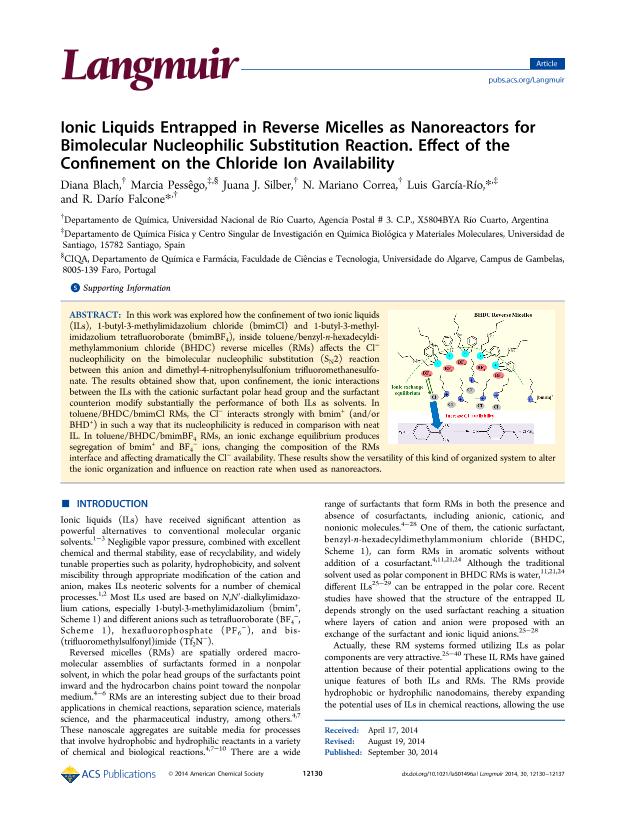Artículo
Ionic Liquids Entrapped in Reverse Micelles as Nanoreactors for Bimolecular Nucleophilic Substitution Reaction. Effect of the Confinement on the Chloride Ion Availability
Blach Vargas, Diana ; Pessêgo, Marcia; Chessa, Juana Josefa
; Pessêgo, Marcia; Chessa, Juana Josefa ; Correa, Nestor Mariano
; Correa, Nestor Mariano ; Garcia Rio, Luis; Falcone, Ruben Dario
; Garcia Rio, Luis; Falcone, Ruben Dario
 ; Pessêgo, Marcia; Chessa, Juana Josefa
; Pessêgo, Marcia; Chessa, Juana Josefa ; Correa, Nestor Mariano
; Correa, Nestor Mariano ; Garcia Rio, Luis; Falcone, Ruben Dario
; Garcia Rio, Luis; Falcone, Ruben Dario
Fecha de publicación:
04/2014
Editorial:
American Chemical Society
Revista:
Langmuir
ISSN:
0743-7463
Idioma:
Inglés
Tipo de recurso:
Artículo publicado
Clasificación temática:
Resumen
In this work was explored how the confinement of two ionic liquids (ILs), 1-butyl-3-methylimidazolium chloride (bmimCl) and 1-butyl-3-methylimidazolium tetrafluoroborate (bmimBF4), inside toluene/benzyl-n-hexadecyldimethylammonium chloride (BHDC) reverse micelles (RMs) affects the Cl– nucleophilicity on the bimolecular nucleophilic substitution (SN2) reaction between this anion and dimethyl-4-nitrophenylsulfonium trifluoromethanesulfonate. The results obtained show that, upon confinement, the ionic interactions between the ILs with the cationic surfactant polar head group and the surfactant counterion modify substantially the performance of both ILs as solvents. In toluene/BHDC/bmimCl RMs, the Cl– interacts strongly with bmim+ (and/or BHD+) in such a way that its nucleophilicity is reduced in comparison with neat IL. In toluene/BHDC/bmimBF4 RMs, an ionic exchange equilibrium produces segregation of bmim+ and BF4– ions, changing the composition of the RMs interface and affecting dramatically the Cl– availability. These results show the versatility of this kind of organized system to alter the ionic organization and influence on reaction rate when used as nanoreactors.
Palabras clave:
Ionic Liquids
,
Reverse Micelles
,
Bhdc
,
Sn2
Archivos asociados
Licencia
Identificadores
Colecciones
Articulos(CCT - CORDOBA)
Articulos de CTRO.CIENTIFICO TECNOL.CONICET - CORDOBA
Articulos de CTRO.CIENTIFICO TECNOL.CONICET - CORDOBA
Citación
Blach Vargas, Diana; Pessêgo, Marcia; Chessa, Juana Josefa; Correa, Nestor Mariano; Garcia Rio, Luis; et al.; Ionic Liquids Entrapped in Reverse Micelles as Nanoreactors for Bimolecular Nucleophilic Substitution Reaction. Effect of the Confinement on the Chloride Ion Availability; American Chemical Society; Langmuir; 30; 41; 4-2014; 12130-12137
Compartir
Altmétricas



